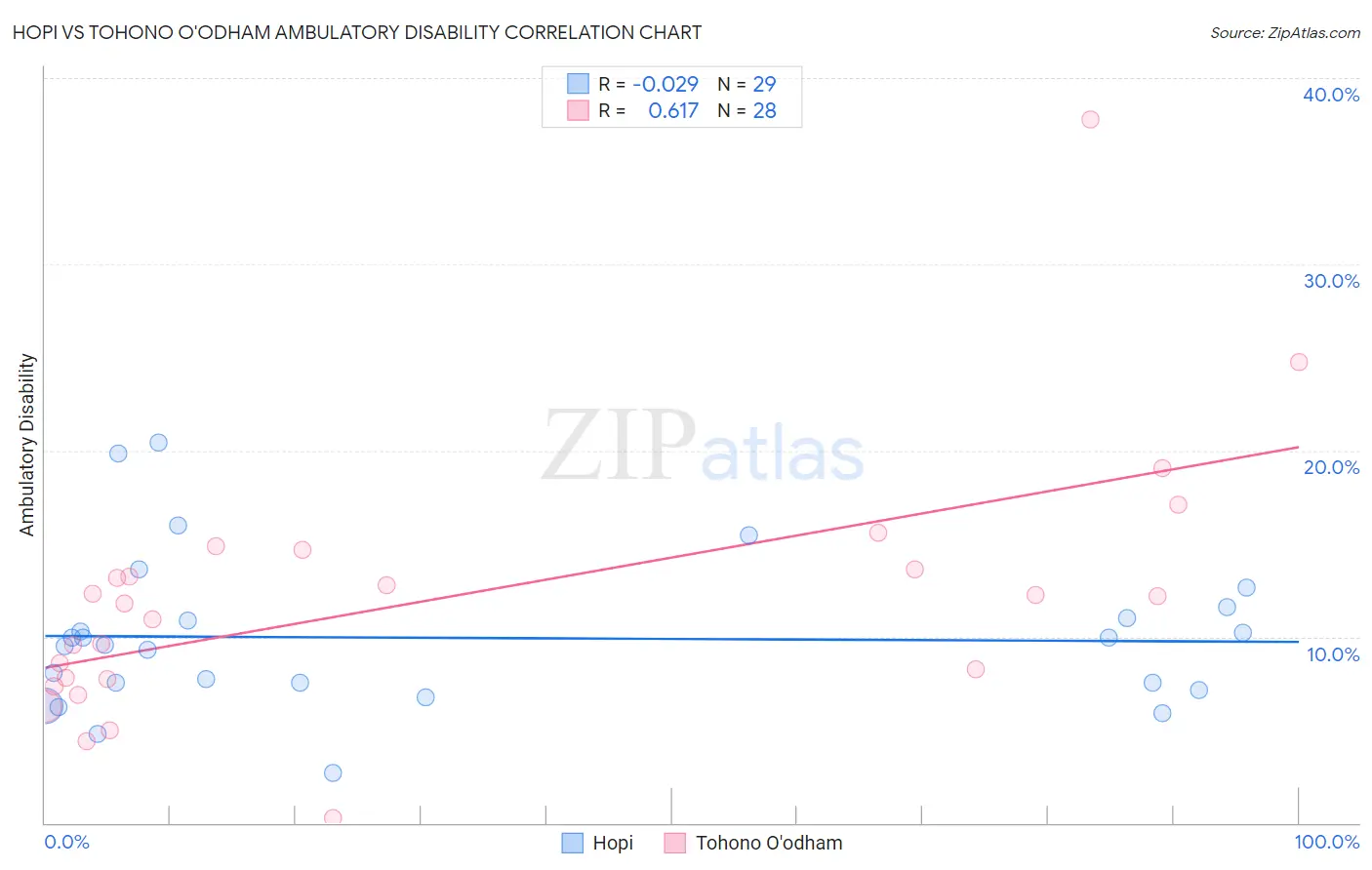Hopi vs Tohono O'odham Ambulatory Disability
COMPARE
Hopi
Tohono O'odham
Ambulatory Disability
Ambulatory Disability Comparison
Hopi
Tohono O'odham
7.6%
AMBULATORY DISABILITY
0.0/ 100
METRIC RATING
328th/ 347
METRIC RANK
8.7%
AMBULATORY DISABILITY
0.0/ 100
METRIC RATING
343rd/ 347
METRIC RANK
Hopi vs Tohono O'odham Ambulatory Disability Correlation Chart
The statistical analysis conducted on geographies consisting of 74,727,187 people shows no correlation between the proportion of Hopi and percentage of population with ambulatory disability in the United States with a correlation coefficient (R) of -0.029 and weighted average of 7.6%. Similarly, the statistical analysis conducted on geographies consisting of 58,714,537 people shows a significant positive correlation between the proportion of Tohono O'odham and percentage of population with ambulatory disability in the United States with a correlation coefficient (R) of 0.617 and weighted average of 8.7%, a difference of 15.0%.

Ambulatory Disability Correlation Summary
| Measurement | Hopi | Tohono O'odham |
| Minimum | 2.7% | 0.26% |
| Maximum | 20.4% | 37.8% |
| Range | 17.7% | 37.5% |
| Mean | 9.9% | 12.1% |
| Median | 9.5% | 12.0% |
| Interquartile 25% (IQ1) | 7.3% | 7.8% |
| Interquartile 75% (IQ3) | 11.3% | 14.2% |
| Interquartile Range (IQR) | 4.0% | 6.4% |
| Standard Deviation (Sample) | 4.1% | 7.0% |
| Standard Deviation (Population) | 4.0% | 6.9% |
Demographics Similar to Hopi and Tohono O'odham by Ambulatory Disability
In terms of ambulatory disability, the demographic groups most similar to Hopi are Pueblo (7.6%, a difference of 0.040%), Native/Alaskan (7.5%, a difference of 0.94%), Black/African American (7.5%, a difference of 0.95%), Comanche (7.5%, a difference of 1.1%), and Paiute (7.7%, a difference of 1.3%). Similarly, the demographic groups most similar to Tohono O'odham are Tsimshian (8.8%, a difference of 0.97%), Kiowa (8.6%, a difference of 1.5%), Puerto Rican (8.9%, a difference of 1.6%), Creek (8.5%, a difference of 3.4%), and Choctaw (8.3%, a difference of 5.1%).
| Demographics | Rating | Rank | Ambulatory Disability |
| Comanche | 0.0 /100 | #325 | Tragic 7.5% |
| Blacks/African Americans | 0.0 /100 | #326 | Tragic 7.5% |
| Natives/Alaskans | 0.0 /100 | #327 | Tragic 7.5% |
| Hopi | 0.0 /100 | #328 | Tragic 7.6% |
| Pueblo | 0.0 /100 | #329 | Tragic 7.6% |
| Paiute | 0.0 /100 | #330 | Tragic 7.7% |
| Cajuns | 0.0 /100 | #331 | Tragic 7.8% |
| Menominee | 0.0 /100 | #332 | Tragic 7.8% |
| Cherokee | 0.0 /100 | #333 | Tragic 7.9% |
| Yuman | 0.0 /100 | #334 | Tragic 7.9% |
| Chickasaw | 0.0 /100 | #335 | Tragic 8.0% |
| Seminole | 0.0 /100 | #336 | Tragic 8.0% |
| Dutch West Indians | 0.0 /100 | #337 | Tragic 8.2% |
| Colville | 0.0 /100 | #338 | Tragic 8.2% |
| Pima | 0.0 /100 | #339 | Tragic 8.2% |
| Choctaw | 0.0 /100 | #340 | Tragic 8.3% |
| Creek | 0.0 /100 | #341 | Tragic 8.5% |
| Kiowa | 0.0 /100 | #342 | Tragic 8.6% |
| Tohono O'odham | 0.0 /100 | #343 | Tragic 8.7% |
| Tsimshian | 0.0 /100 | #344 | Tragic 8.8% |
| Puerto Ricans | 0.0 /100 | #345 | Tragic 8.9% |